2012-2013 News in Medieval and Early Modern Studies
Darryl Gless Receives 2013 Board of Governors’ Nomination for Excellence in Teaching
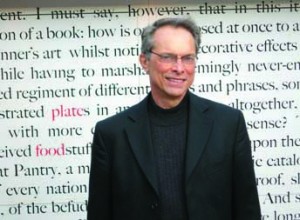 Darryl Gless (English and Comparative Literature, early modern) has received UNC’s most prestigious teaching award, this year’s nominee for the Board of Governors’ Award for Excellence in Teaching. This award is given to a tenured faculty member on each campus of the UNC system for exceptional undergraduate teaching over a sustained period of time.Gless is Roy C. Moose Distinguished Professor of Renaissance Studies, and immediate past director of UNC’s Program in Medieval and Early Modern Studies.
Darryl Gless (English and Comparative Literature, early modern) has received UNC’s most prestigious teaching award, this year’s nominee for the Board of Governors’ Award for Excellence in Teaching. This award is given to a tenured faculty member on each campus of the UNC system for exceptional undergraduate teaching over a sustained period of time.Gless is Roy C. Moose Distinguished Professor of Renaissance Studies, and immediate past director of UNC’s Program in Medieval and Early Modern Studies.
Excerpt from the award: Students, past and present, say Glass epitomizes the value of the liberal arts in developing an understanding for how to live a better life through critical questioning. He “shifts easily from taking apart the iambic pentameter of Shakespeare’s sonnets to helping me put together a larger life plan with real purpose and large meaning,” a nominator said. Through constant questioning, Glass adroitly weaves insights from history, science, religion and his students into the text, another said. He conducts both discussions and assignment critiques with the highest principles of respect. “Every student left class sessions feeling as though their opinions were valued and cherished,” a student commented.
Glaire Anderson Explores Digital Initiatives
 Thanks to a MEMS travel grant, Glaire Anderson examined a group of 8th c. Umayyad aristocratic estates in Syria, Jordan, Israel and Palestine. A collaboration with Anselmo Lastra and UNC Computer Science resulted in a 3-D visualization of the most spectacular of the sites, Khirbat al-Mafjar (also known as Hisham’s Palace) in Jericho. Anderson subsequently had students in her Maymester “Art in the Age of the Caliphs” class work with the 3-D model, in a group research project called “An Early Islamic Estate.” Anderson hopes to have students work on it again in her upcoming Maymester course.”
Thanks to a MEMS travel grant, Glaire Anderson examined a group of 8th c. Umayyad aristocratic estates in Syria, Jordan, Israel and Palestine. A collaboration with Anselmo Lastra and UNC Computer Science resulted in a 3-D visualization of the most spectacular of the sites, Khirbat al-Mafjar (also known as Hisham’s Palace) in Jericho. Anderson subsequently had students in her Maymester “Art in the Age of the Caliphs” class work with the 3-D model, in a group research project called “An Early Islamic Estate.” Anderson hopes to have students work on it again in her upcoming Maymester course.”
The Uses and Abuses of Time: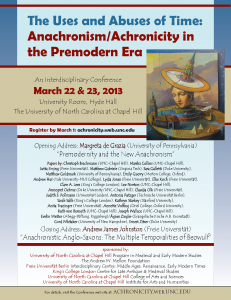 Anachronism/Achronicity in the
Anachronism/Achronicity in the
Premodern World (1000–1700)
The conference, March 22–23, 2013 at Carolina, was an academic collaboration between MEMS, the Freie Universität Berlin, and King’s College London. A keynote address was delivered by Margreta de Grazia (University of Pennsylvania), and Andrew James Johnston (Freie Universität Berlin) delivered the closing address.
Sahar Amer Teaching New MEMS Graduate Seminar in Spring 2013
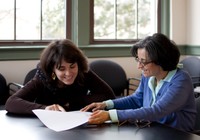 Created with support from a MEMS Seminar Development Grant, Professor Amer’s course, FREN 662 Cultural Diversity in Medieval France, offers an introduction to medieval French literature with a thematic focus on French interactions with the Arab Islamicate world from the eleventh to the thirteenth centuries. The seminar meets Wednesdays from 2:00 to 5:00 p.m.
Created with support from a MEMS Seminar Development Grant, Professor Amer’s course, FREN 662 Cultural Diversity in Medieval France, offers an introduction to medieval French literature with a thematic focus on French interactions with the Arab Islamicate world from the eleventh to the thirteenth centuries. The seminar meets Wednesdays from 2:00 to 5:00 p.m.
Marta Ajmar of Victoria and Albert Museum Delivers February 11 MEMS Dorothy Ford Wiley Crossroads Lecture
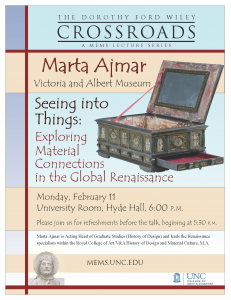 Marta Ajmar is Acting Head of Graduate Studies (History of Design) and leads the Renaissance specialism within the Royal College of Art/V&A History of Design and Material Culture, M.A. program. She led the research for and co-curated the major Victoria and Albert Museum exhibition At Home in Renaissance Italy (2006). Her research interests lie principally in the material culture of Renaissance and Early Modern Italy and the Mediterranean world. Ajmar has published on the domestic interior, gender, eroticism, sociability, the material culture of childhood and ‘global’ objects. More recently she has focused on two broad areas: health and wellbeing and artisanal practices. Her teaching is broadly informed by these interests.
Marta Ajmar is Acting Head of Graduate Studies (History of Design) and leads the Renaissance specialism within the Royal College of Art/V&A History of Design and Material Culture, M.A. program. She led the research for and co-curated the major Victoria and Albert Museum exhibition At Home in Renaissance Italy (2006). Her research interests lie principally in the material culture of Renaissance and Early Modern Italy and the Mediterranean world. Ajmar has published on the domestic interior, gender, eroticism, sociability, the material culture of childhood and ‘global’ objects. More recently she has focused on two broad areas: health and wellbeing and artisanal practices. Her teaching is broadly informed by these interests.
2012 MEMS Faculty Books
The Islamic Villa in Early Medieval Iberia: Architecture and Court Culture in Umayyad Córdoba (Ashgate, 2012)
Glaire Anderson‘s study explores the aristocratic villas and court culture of Córdoba, during its “golden age” under the reign of the Umayyad dynasty (r. 756–1031 AD). Mariam Rosser-Owen, Victoria and Albert Museum, called it ” . . . an innovative study and an enjoyable read, conjuring a world of palaces and gardens, but providing at the same time a rigorous and serious study of the villa’s function and meaning at the Umayyad court at an important moment of the dynasty’s establishment and legitimation.”
Reassessing the Roles of Women as ‘Makers’ of Medieval Art and Architecture (Brill, 2012)
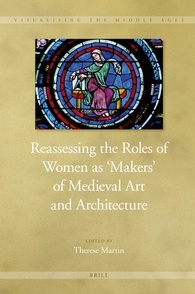 Essays by Glaire Anderson (Art History, medieval) and Jaroslav Folda (Art History, medieval) are included in this important two-volume set that proposes a renewed way of framing the debate around the history of medieval art and architecture to highlight the multiple roles played by women.
Essays by Glaire Anderson (Art History, medieval) and Jaroslav Folda (Art History, medieval) are included in this important two-volume set that proposes a renewed way of framing the debate around the history of medieval art and architecture to highlight the multiple roles played by women.
The Works of Lucy Hutchinson, Volume I: The Translation of Lucretius (Oxford University Press, 2012)
 Hutchinson’s was the first complete English translation of one of the great classical poems, Lucretius’s De rerum natura.This new edition, edited by Reid Barbour (English, early modern) and David Norbrook, provides the Latin text she mainly used, that of Daniel Pareus (1631), on facing pages. A line-by-line commentary explores every aspect of the translation.
Hutchinson’s was the first complete English translation of one of the great classical poems, Lucretius’s De rerum natura.This new edition, edited by Reid Barbour (English, early modern) and David Norbrook, provides the Latin text she mainly used, that of Daniel Pareus (1631), on facing pages. A line-by-line commentary explores every aspect of the translation.
The Mystical Science of the Soul: Medieval Cognition in Bernardino de Laredożs Recollection Method(University of Toronto Press)
 The Mystical Science of the Soul explores the unexamined influence of medieval discourses of science and spirituality on recogimiento, the unique Spanish genre of recollection mysticism that served as the driving force behind the principal developments in Golden Age mysticism. Building on recent research in medieval optics, physiology, and memory in relation to the devotional practices of the late Middle Ages, Jessica A. Boon (Religious Studies, medieval and early modern) probes the implications of an ‘embodied soul’ for the intellectual history of Spanish mysticism.
The Mystical Science of the Soul explores the unexamined influence of medieval discourses of science and spirituality on recogimiento, the unique Spanish genre of recollection mysticism that served as the driving force behind the principal developments in Golden Age mysticism. Building on recent research in medieval optics, physiology, and memory in relation to the devotional practices of the late Middle Ages, Jessica A. Boon (Religious Studies, medieval and early modern) probes the implications of an ‘embodied soul’ for the intellectual history of Spanish mysticism.
Tudorism: Historical Imagination and the Appropriation of the Sixteenth Century (Oxford University Press, 2012)
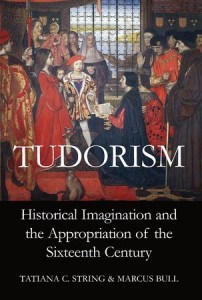 Tania String (Art History, Early Modern) and Marcus Bull (History, Medieval) have put together the first in-depth and wide-ranging academic exploration of the reception of the Tudor period in the modern world. It includes studies by many of the leading scholars in their fields, and considers the modern appropriation of the Tudors and their era in art, music, architecture, design, religion, public history, social history, print, film and television, and internet networking sites. The fourteen papers cumulatively map out the ways in which modern society has utilized the sixteenth-century past as a cultural resource, as a repertoire of quotable designs and styles, as a vantage point from which to frame political and social critiques, as a source of identities, and as a refuge from modern-day anxieties.
Tania String (Art History, Early Modern) and Marcus Bull (History, Medieval) have put together the first in-depth and wide-ranging academic exploration of the reception of the Tudor period in the modern world. It includes studies by many of the leading scholars in their fields, and considers the modern appropriation of the Tudors and their era in art, music, architecture, design, religion, public history, social history, print, film and television, and internet networking sites. The fourteen papers cumulatively map out the ways in which modern society has utilized the sixteenth-century past as a cultural resource, as a repertoire of quotable designs and styles, as a vantage point from which to frame political and social critiques, as a source of identities, and as a refuge from modern-day anxieties.
The Problem with Multiculturalism: The Uniqueness and Universality of Western Civilization (Transaction Publishers, 2012)
 John Headley’s (History, early modern, emeritus) principal goal here is to establish the uniqueness and universality of the West then to critique multiculturalism’s failure to recognize these special characteristics. He looks to civilization rather than to the nation-state as he argues for this uniqueness, which was evident from the West’s very beginnings. Headley also seeks to advance the ever-contentious discussion about secularization. To understand secularization and how it operates from a naturalistic perspective, one must see civilization itself as a defining element in world affairs.
John Headley’s (History, early modern, emeritus) principal goal here is to establish the uniqueness and universality of the West then to critique multiculturalism’s failure to recognize these special characteristics. He looks to civilization rather than to the nation-state as he argues for this uniqueness, which was evident from the West’s very beginnings. Headley also seeks to advance the ever-contentious discussion about secularization. To understand secularization and how it operates from a naturalistic perspective, one must see civilization itself as a defining element in world affairs.
Greek and Roman Animal Sacrifice: Ancient Victims, Modern Observers (Cambridge University Press, 2012)
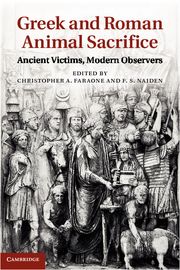 This book of essays challenges the prevailing view of the most important ritual in Greek and Roman religion, animal sacrifice, and it is the first book on sacrifice to combine the study of Greek and Roman practices while putting the two on a par with one another. Contributors come from the Collège de France and Oxford, Harvard, Chicago and Ohio State Universities as well as from UNC-Chapel Hill. Co-editors are Fred Naiden (History) and Christopher A. Faraone (University of Chicago).
This book of essays challenges the prevailing view of the most important ritual in Greek and Roman religion, animal sacrifice, and it is the first book on sacrifice to combine the study of Greek and Roman practices while putting the two on a par with one another. Contributors come from the Collège de France and Oxford, Harvard, Chicago and Ohio State Universities as well as from UNC-Chapel Hill. Co-editors are Fred Naiden (History) and Christopher A. Faraone (University of Chicago).
Smoke Signals for the Gods: Ancient Greek Sacrifice from the Archaic through Roman Periods (Oxford University Press 2012)
This 421-page monograph continues Fred Naiden‘s work on ancient sacrifice in the edited volume Greek and Roman Animal Sacrifice: Ancient Victims, Modern Observers, published earlier this year by Cambridge. Jan Bremmer of the University of Groningen says that the monograph “. . . transcends older studies. . . . All students will from now on have to start with [t]his book. It is a milestone in the field.”
Highways, Byways, and Road Systems in the Pre-Modern World (Wiley-Blackwell, 2012)
 The book, co-edited by Richard Talbert (History), Susan E. Alcock and John Bodel, includes Talbert’s introduction and his essay on Roman road systems as well as thirteen other chapters from contributors in North America and Europe. The geographical journey on these roads leads readers from ancient Rome and China across the world to Incan and Mayan societies and into the cultures of India, Saharan Africa, the Middle East, and Japan. The volume provides an extraordinary global and chronological perspective on the history of communication networks, or what Nicholas Purcell of Oxford calls a “splendid gallery of ideas about roads of every kind.”
The book, co-edited by Richard Talbert (History), Susan E. Alcock and John Bodel, includes Talbert’s introduction and his essay on Roman road systems as well as thirteen other chapters from contributors in North America and Europe. The geographical journey on these roads leads readers from ancient Rome and China across the world to Incan and Mayan societies and into the cultures of India, Saharan Africa, the Middle East, and Japan. The volume provides an extraordinary global and chronological perspective on the history of communication networks, or what Nicholas Purcell of Oxford calls a “splendid gallery of ideas about roads of every kind.”
New Director for MEMS
 Darryl J. Gless (English, early modern), having directed MEMS for three years, is returning to full-time scholarship. The program grew and thrived under his leadership, and is grateful that he plans to remain an active participant. The new director is Brett E. Whalen (History, medieval), who has overseen the program’s minor. He assumed his duties on July 1, 2012.
Darryl J. Gless (English, early modern), having directed MEMS for three years, is returning to full-time scholarship. The program grew and thrived under his leadership, and is grateful that he plans to remain an active participant. The new director is Brett E. Whalen (History, medieval), who has overseen the program’s minor. He assumed his duties on July 1, 2012.
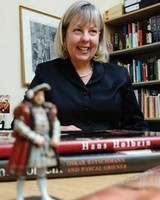 Tania String Offers Fall 2012 MEMS Seminar
Tania String Offers Fall 2012 MEMS Seminar
Awarded a MEMS Seminar Development Grant, Tania String secured additional support from the University and the North Carolina Museum of Art to make it an exceptional theoretical and hands-on learning opportunity. The Tudor and Jacobean Portraits: A Theoretical and Practical Investigation is offered on Tuesdays from 2:00 to 5:00 p.m. Those taking this unit are playing an active part in researching a group of relatively unstudied works of art, and gaining valuable art historical and museological skills.
MEMS Alumni News
Allison Bigelow (Ph.D. 2012, English & Comparative Lit., early literatures of the Americas) has been appointed the two-year NEH/Institute Postdoctoral Fellow at the Omohundro Institute of Early American History and Culture at the College of William & Mary, where she will teach one course per year while revising her manuscript for publication with the Omohundro/UNC Press.
